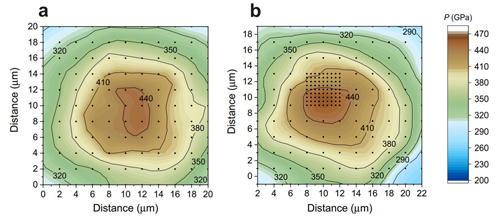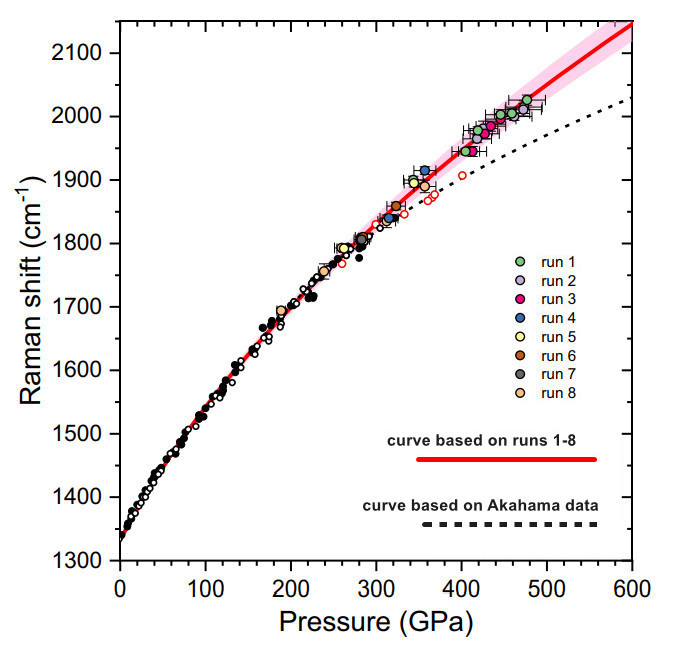
Diamond anvil cells (DACs) are a valuable tool to measure samples under extreme pressures. Scientists are interested in observing samples under these pressures to learn more about conditions at the earth’s core and the mechanics of giant planets, and potentially to discover new materials with useful properties, such as high temperature superconductivity.
A diamond anvil uses a pair of diamonds to squeeze tiny samples between them, and the diamonds' transparency allows both lasers and high-energy X-rays to probe the highly pressurized samples. After decades of development, DACs have become capable of applying pressures exceeding 100 gigapascals (about a million atmospheres).
Recent advances in DAC technology produce pressures approaching one terapascal, or some ten million times standard atmospheric pressure. Such pressures occur deep within the gas giant planets, notably Jupiter and Saturn, which are composed mostly of hydrogen and helium. At these extreme pressures hydrogen may become metallic and superconducting.
While advances in DAC technology open a new window into terapascal-range phenomena, accurately measuring such ultra-high pressures is difficult. To address this issue, a collaborative research team recently employed high-energy X-rays at the Advanced Photon Source (APS), a U.S. Department of Energy (DOE) Office of Science user facility at DOE’s Argonne National Laboratory, for high-pressure measurements.

Both X-ray diffraction and Raman spectroscopy were employed in a complementary approach to probe the interior environments of eight high-pressure diamond anvils. Combining the experimental data with theoretical models allowed the researchers to accurately gauge DAC pressures up to 0.5 terapascals. Based on their findings, the researchers determined that previous measurement techniques have sometimes overestimated DAC pressures by up to 20 percent. The techniques demonstrated in this study will allow scientists to confidently explore the effects of extremely high pressures on a variety of materials.
For this study Raman spectroscopy was used to measure materials under such high pressures. When light passes through a material, a tiny proportion excites the material's molecules, which then re-emit photons characteristic of those molecules. This principle is employed in optical Raman spectroscopy, which is used to probe the vibrational and rotational characteristics of molecules. The same basic principles apply for probing the vibrational properties of diamonds. As pressures increase, the characteristic vibrations of diamonds shift to higher frequencies. This shift of diamond vibration can indicate the pressure distribution in a DAC, including at the diamond tip where the pressure is highest.
A highly intense beam of monochromatic X-rays at the GeoSoilEnviroCARS beamline at 13-ID-D was used for high-resolution X-ray diffraction measurements in combination with off-line Raman spectroscopic measurements. Because different diamond geometries affect pressure distribution in unique ways, the researchers examined eight diamond anvil cells, each with its own distinctive diamond shape. Gold was used as the sample material in each DAC. To calibrate the Raman measurements, powder X-ray diffraction mapping was performed on each gold sample at the same beamline and under the same conditions. X-ray diffraction indicated the volume of gold placed between the tips of each diamond anvil, and from this the pressure in each DAC was calculated and compared with Raman measurements.
The researchers also squeezed gold and hydrogen together, and then measured the vibrational shift of the highly pressurized hydrogen. The choice of gold was important in this context since, unlike the majority of metals, it is mostly chemically inert and will not form hydrides (hydrogen compounds) even under extremely high pressures and temperatures. The high-pressure inertness of gold is vital since the presence of hydrides can negatively impact calculations.
These results demonstrate the capability of Raman edge spectroscopy to accurately measure extremely high-pressure DAC environments. – Philip Koth
See: M.I. Eremets1,, V.S. Minkov1, P.P. Kong1, A.P. Drozdov1, S. Chariton2, V.B. Prakapenka2, “Universal Diamond Edge Raman Scale to 0.5 Terapascal and Implications for the Metallization of Hydrogen,” Nat Commun 14, 907 (2023).
Author affiliations: 1Max Planck Institute for Chemistry; 2University of Chicago
Correspondence: [email protected]
X-ray diffraction were performed at GeoSoilEnviroCARS (The University of Chicago, Sector 13), Advanced Photon Source (APS), Argonne National Laboratory (runs 1–7) and DESY (Hamburg, Germany), a member of the Helmholtz Association HGF (run 8). GeoSoilEnviro CARS is supported by the National Science Foundation-Earth Sciences (EAR-1634415) and Department of Energy-GeoSciences (DE-FG02-94ER14466). This research used resources of the Advanced Photon Source, a U.S. Department of Energy (DOE) Office of Science User Facility operated for the DOE Office of Science by Argonne National Laboratory under Contract No. DE-AC02-06CH11357. Parts of this research were carried out at PETRA-III using P02.2.
The U.S. Department of Energy's APS at Argonne National Laboratory is one of the world’s most productive x-ray light source facilities. Each year, the APS provides high-brightness x-ray beams to a diverse community of more than 5,000 researchers in materials science, chemistry, condensed matter physics, the life and environmental sciences, and applied research. Researchers using the APS produce over 2,000 publications each year detailing impactful discoveries and solve more vital biological protein structures than users of any other x-ray light source research facility. APS x-rays are ideally suited for explorations of materials and biological structures; elemental distribution; chemical, magnetic, electronic states; and a wide range of technologically important engineering systems from batteries to fuel injector sprays, all of which are the foundations of our nation’s economic, technological, and physical well-being.
Argonne National Laboratory seeks solutions to pressing national problems in science and technology. The nation's first national laboratory, Argonne conducts leading-edge basic and applied scientific research in virtually every scientific discipline. Argonne researchers work closely with researchers from hundreds of companies, universities, and federal, state and municipal agencies to help them solve their specific problems, advance America's scientific leadership and prepare the nation for a better future. With employees from more than 60 nations, Argonne is managed by UChicago Argonne, LLC, for the U.S. DOE Office of Science.
The U.S. Department of Energy's Office of Science is the single largest supporter of basic research in the physical sciences in the United States and is working to address some of the most pressing challenges of our time. For more information, visit the Office of Science website.
